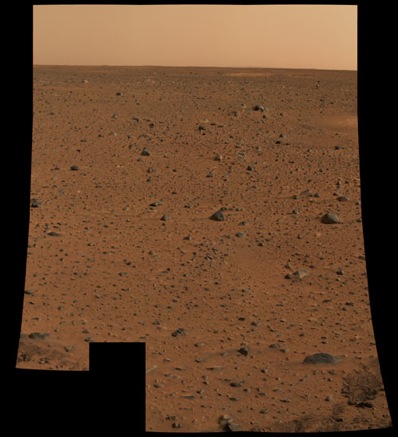



|

|

The race to free Spirit
KEITH COOPER
ASTRONOMY NOW
Posted: 04 January 2010


Six years ago today NASA’s little Mars rover Spirit bounced down in its air bag into the 170-kilometre wide Gusev Crater, but despite defying all expectations by overcoming killer dust storms, a dodgy right front wheel and malfunctioning computers, Spirit’s time may soon be up if it cannot be freed from a deadly sand trap within the next month.
 Attempts to free Spirit haven’t given the rover the nudge it needs to escape the sand trap, but only for it to sink further. Image: NASA/JPL–Caltech. Attempts to free Spirit haven’t given the rover the nudge it needs to escape the sand trap, but only for it to sink further. Image: NASA/JPL–Caltech.
When the rover landed at 4:35am GMT on 4 January 2004, the plan was for just a quick 90-day mission, but like its twin Opportunity, Spirit’s longevity has been legendary, having now been on the Martian surface for 3.2 Martian years (one year on Mars is 23 months on Earth). It has roamed around Gusev Crater, visiting rocky outcrops such as the one nicknamed ‘Home Plate’ that shows evidence of a wet, steamy and volcanic past. Spirit found concentrated silicate deposits, which formed in the hot springs emerging from volcanic vents (a so-called ‘fumarolic’ environment). “We imagine there was some kind of hydrothermal system where there was water underground that became hot after coming into contact with volcanic materials, and then reached the surface as either water or steam geysers,” says Steve Squyres, the rover’s Principal Investigator from Cornell University, USA.
 The first colour image beamed back by Spirit shortly after it landed in 2004. Image: NASA/JPL/Cornell. The first colour image beamed back by Spirit shortly after it landed in 2004. Image: NASA/JPL/Cornell.
The silica deposits are more than 90 percent pure, and are found just beneath the dust layer in the thick sand. “It’s pretty insidious stuff to drive in,” comments Squyres, and Spirit has found that out to its downfall. In March 2009 the rover became stuck in a sand trap in a region close to Home Plate called Troy and, despite spinning its remaining working wheels in the churning sand, it has remained trapped. Efforts to free Spirit have seen it sink even further, and the failure of its right rear wheel a month ago has not helped matters (despite the right front wheel coming back to life, intermittently). As the Martian winter gets ever closer, the temperatures drop ever lower and sunlight incident on the rover’s solar arrays falls as the Sun drops nearer to the horizon.
 Looking down on itself with it’s ‘pancam’, Spirit photographs its dusty solar panels in December 2007. The dustier they get, the less solar power can be generated, further harming the rover’s chances of survival. Image: NASA/JPL–Caltech/Cornell. Looking down on itself with it’s ‘pancam’, Spirit photographs its dusty solar panels in December 2007. The dustier they get, the less solar power can be generated, further harming the rover’s chances of survival. Image: NASA/JPL–Caltech/Cornell.
If the rover team cannot extricate Spirit from Troy by the end of January, they will have to admit defeat in a desperate effort to save power. Because Spirit is tilted five degrees to the south, and the Sun is low over the northern horizon, then come May Spirit will no longer be able to generate enough power from its solar panels to keep running. Even if they can get Spirit level, it will barely be enough.
“At the current rate of dust accumulation [on the solar panels], solar arrays with zero tilt would provide barely enough energy to run the survival heaters through the Mars winter solstice” says Jennifer Herman, a rover power engineer at JPL. One tactic might be to dig the rover’s wheels even deeper into the northern side to balance out the tilt.

 Top: Bonneville Crater, which Spirit visited in March 2004. Bottom: A panoramic view of the volcanic Home Plate taken by Spirit taken in 2006. Image: NASA/JPL–Caltech/USGS/Cornell. Image: NASA/JPL/Cornell. Top: Bonneville Crater, which Spirit visited in March 2004. Bottom: A panoramic view of the volcanic Home Plate taken by Spirit taken in 2006. Image: NASA/JPL–Caltech/USGS/Cornell. Image: NASA/JPL/Cornell.
If they can improve Spirit’s tilt, there will still be plenty of science to do even if the rover is stationary – in fact, there will be some science for it to do that would have been impossible were it mobile. By using radio signals to measure the wobble of the planet’s rotation, it would be possible to learn something about Mars’ core. Short period changes could tell us whether the core is solid iron, or still molten, while longer period changes could tell us about the size and density of the core, but such measurements cannot be made by a mobile rover.
“Spirit could continue significant research right where it is. We can study the interior of Mars, monitor the weather and continue examining the interesting deposits uncovered by Spirit’s wheels,” says Spirit’s Deputy Principal Investigator, Ray Arvidson of Washington University, who remains optimistic about the rovers, regardless of what the future has in store. “We are so far out of warranty that I cannot predict how much longer both Spirit and Opportunity will survive. They just keep going and going and the more they go the more they discover.”
|

|

|

|
|



